Some of the birds are quick to stand out and have orange heads. Most species that show an orange head are adapted to vivid coloring during the breeding season.
Male birds change their typical duller head color to an orange color to attract the attention of their female partners.
In rare cases, both male and female species may show similar orange heads.
These types of birds are found across The Americas, Africa, Europe, Asia, and Australia’s rainforests.
Sometimes living in large colonies, birds with an orange head might be easy to spot in their feeding or breeding colonies.
Mostly tied to tropical, sub-tropical, arid, and rainforest climates, these birds may also make their way to cooler temperate climates, particularly among the migratory species.
Here are some of the most common birds of the world with an orange head at least in the case of the males.
Table of Contents
1. Western Tanager
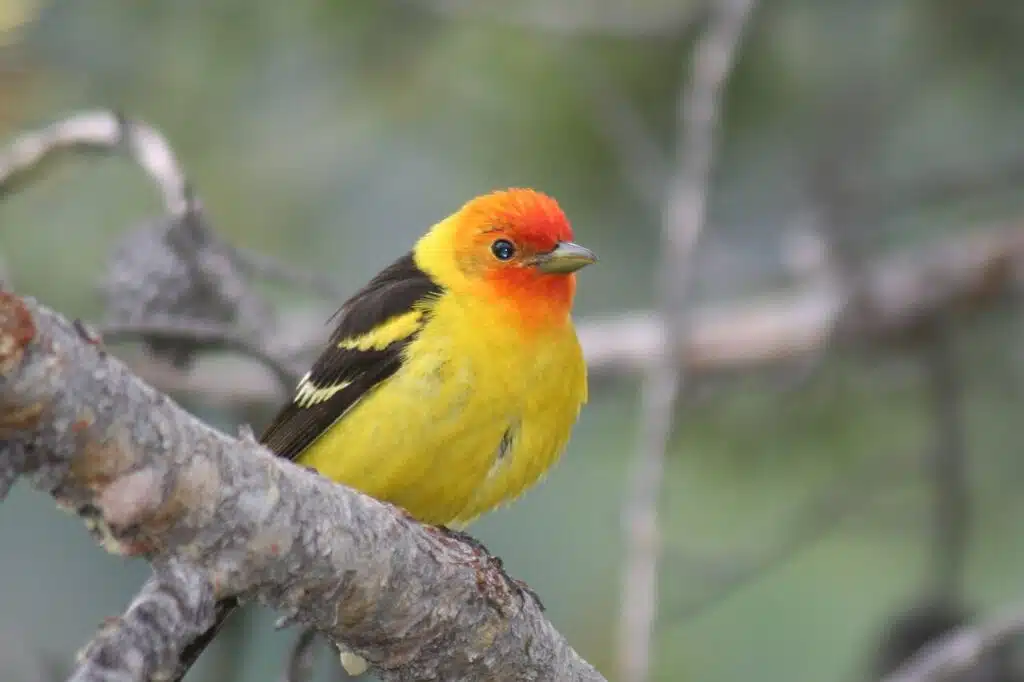
A colorful orange head inspires the name of The Western Tanager (Piranga ludoviciana), together with its North American range.
Bright orange heads are specific to males of the species which are contrasted by yellow chests and belies and by black wings.
Males also exhibit yellow marks across the wings.
Western Tanager females are marked by an olive color and dark gray wings with white marks.
Breeding in North America along The Rocky Mountains, Western Tanagers may also migrate, typically in very small groups.
Some of these groups may reach Mexico to overwinter before making their way back North.
Distribution – Western North America, Central America
Orange head – adult male
2. Hooded Oriole
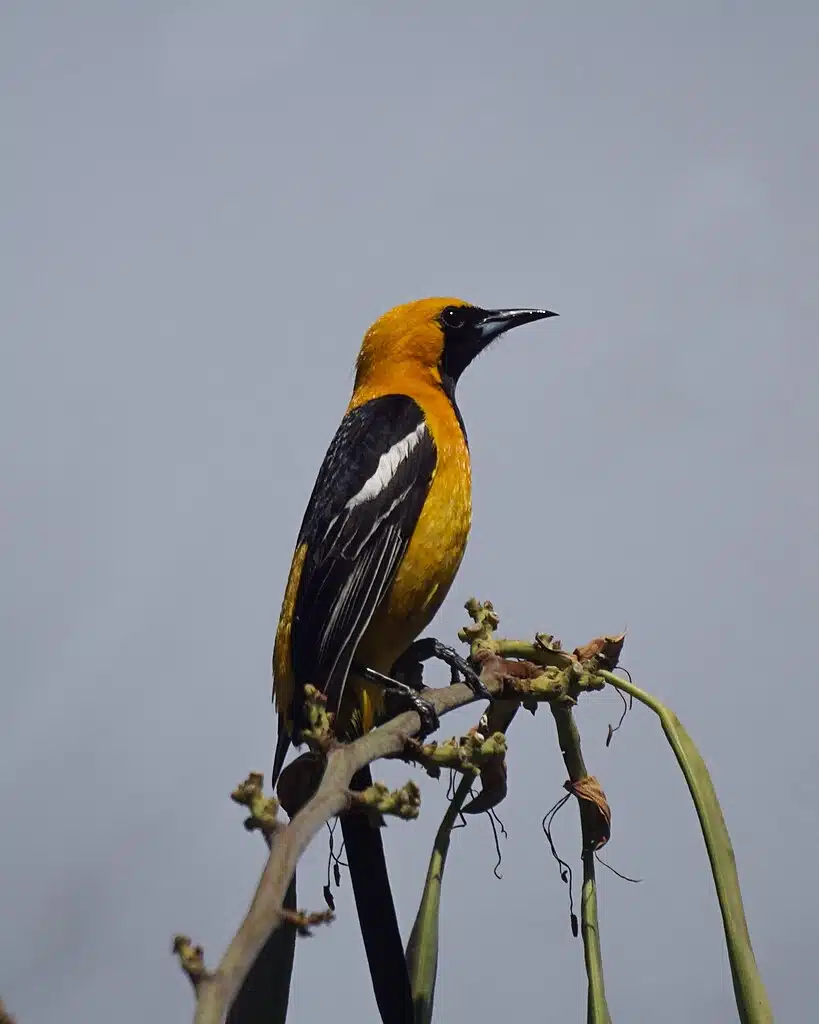
An orange head of various shades is characteristic of The Hooded Oriole (Icterus cucullatus) male.
Its head can be bright orange or dark orange, with a black contrasting face and bill. Its wings and long tail are also black.
The orange coloring is further seen on the chest and underbelly.
Females of the species are dominated by olive or olive-yellow colors. They also exhibit darker wings but lack the orange nuance seen in males.
Sometimes seen in North America, these colorful birds are acrobatic omnivores.
They eat all types of insects but may also pick fruit from unusual positions such as when hanging upside down.
Some of the best times to see these birds include the period between the beginning of spring to August.
Distribution – Southern California, Rio Grande Valley Texas, Southern Arizona, Mexico
Orange head – adult male
3. Bullock’s Oriole
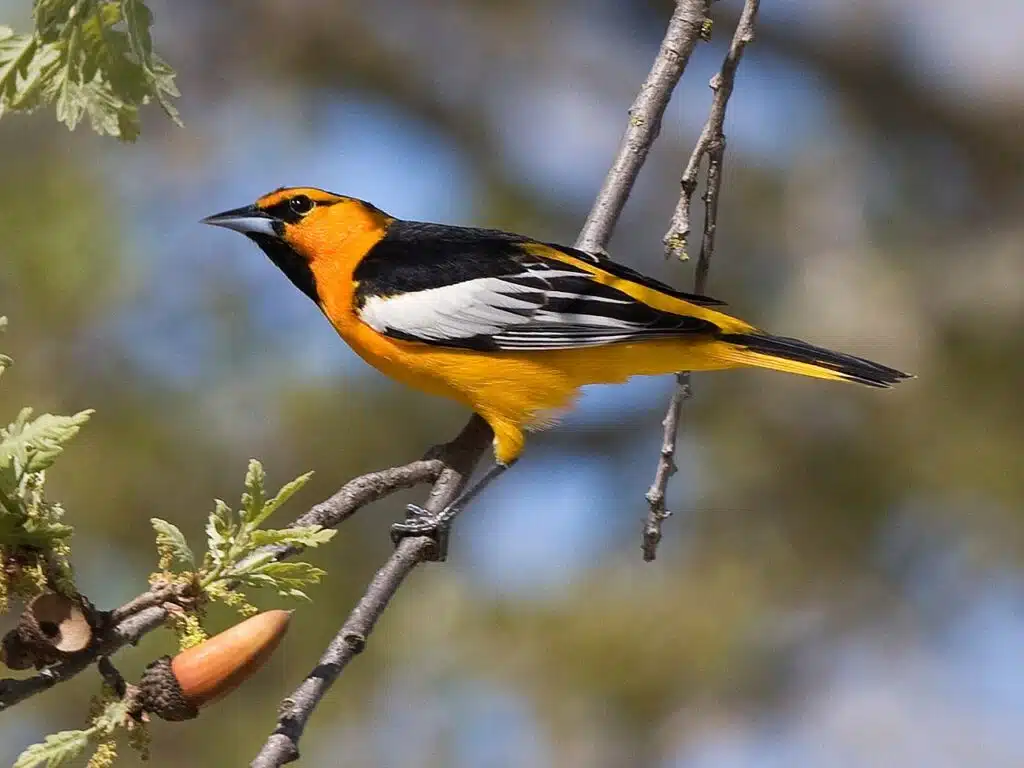
A darker orange nuance (compared to Hooded Orioles) is specific to the male Bullock’s Oriole (Icterus bullockii) head.
This species has a vivid orange head with a black crown and an orange-black color combination across its body.
Females are brighter, dominated by a white chest and underbelly with a yellow back and head.
Bullock’s Orioles are present in a wider Western territory across North America compared to Hooded Orioles as they even breed in Canadian territories as well as along The Rockies.
Birds of this species have a diverse diet, specific to orioles. They eat small insects and a wide range of fruit.
Their diet includes large fruit such as oranges.
Distribution – Western North America, Central America
Orange head – adult male
4. Rufous Hummingbird
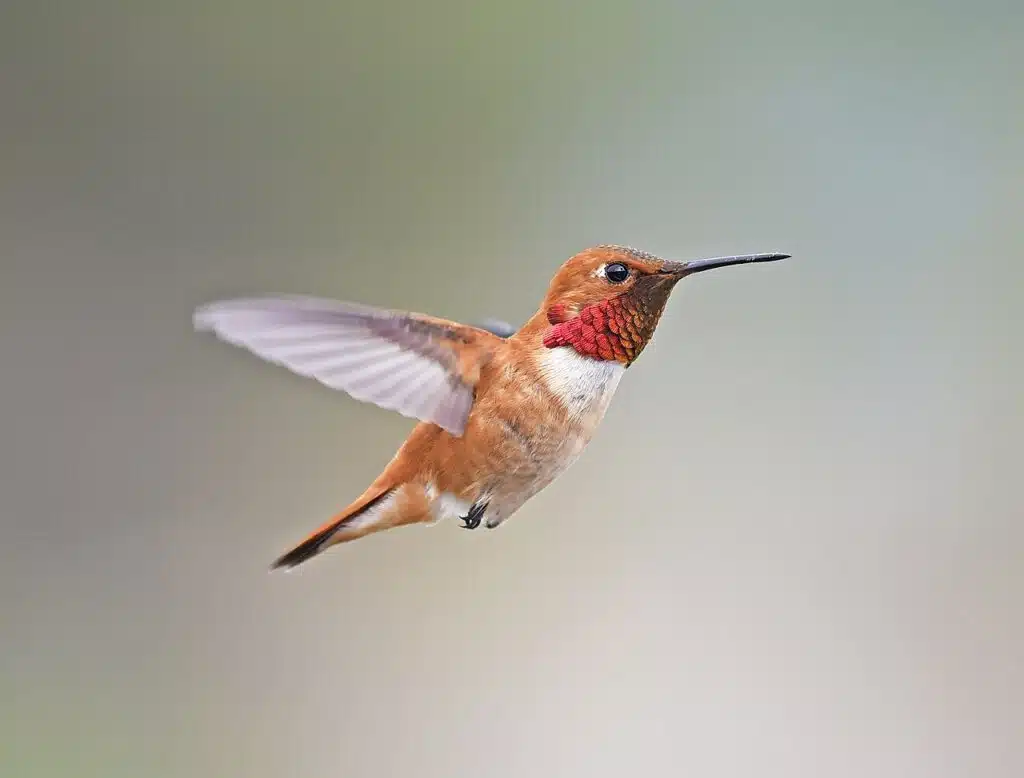
An orange head and a brown crown are characteristic of the male Rufous Hummingbird (Selasphorus rufus) in its breeding season.
This is a type of iridescent orange color that may sometimes be spotted on some females as well.
However, most female Rufous Hummingbirds have a base brown color and a green crown.
The differences between the males and females of the species are further visible in their habits. For example, the migration process is started by males which move out first.
These hummingbirds eat both insects and plant nectar.
Distribution – Northwestern North America, Gulf of Mexico, Central America
Orange head – adult male
5. Red Crossbill
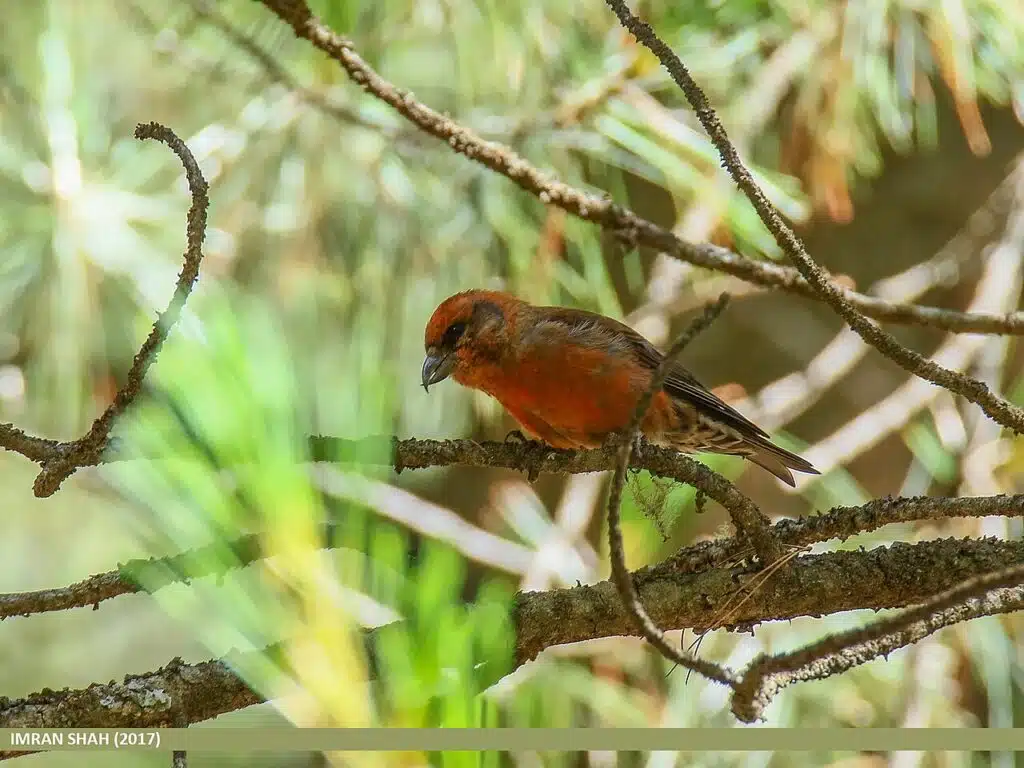
Rusty orange heads are characteristic of the male Red Crossbills (Loxia curvirostra). These birds have continuous orange coloring from their heads to their underbellies.
Females of the species are also colorful but dominated by yellow with additional white and gray contrasting areas.
The name of these birds is inspired by their crossed bill shape, an adaptation towards easier feeding.
The species is partially migratory across the world. Some of the parts of the world it migrates towards include Eastern North America from The Rockies to The Atlantic.
It also has a migratory status in The Iberian Peninsula in Europe.
Distribution – North America, Europe, Asia
Orange head – adult male
6. Altamira Oriole
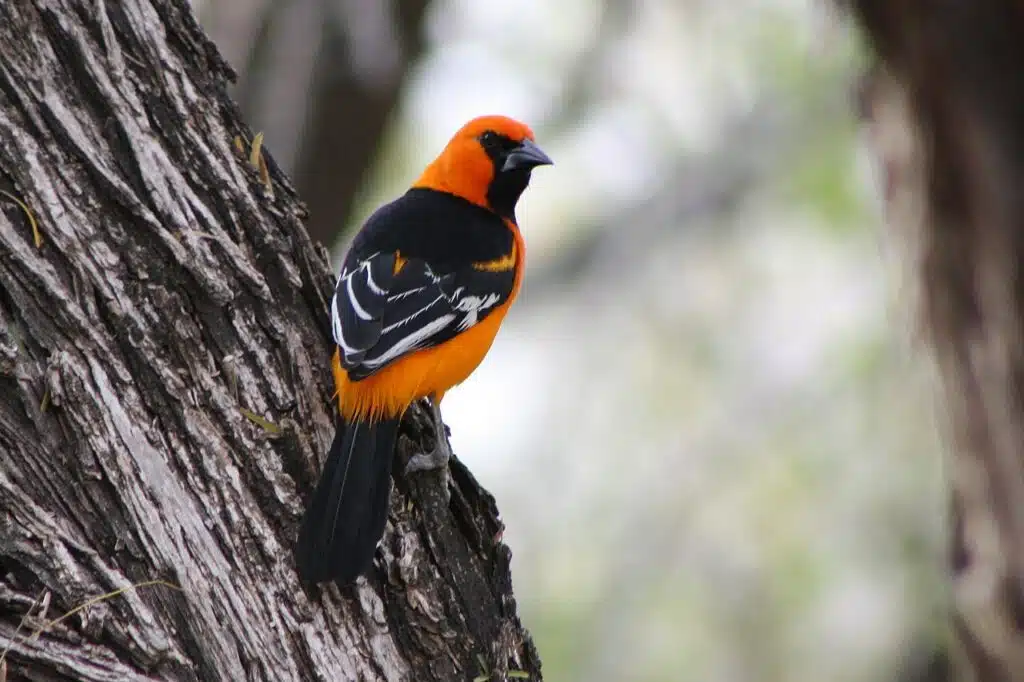
A colorful head is characteristic of the Altamira Orioles (Icterus gularis). These birds show bright orange heads.
They also have a dark orange body and contrasting black and white wings.
When they reach adulthood, Altamira Orioles also show a black face and a black bill.
Juveniles of the species have a similar color pattern but they are mostly yellow before becoming orange.
The living area of these birds includes areas around water in almost arid territories.
Their presence is high in areas of Mexico along rivers and streams.
Much of their lives are unknown to humans due to their remote living areas and due to their solitary habits.
Distribution – Central America
Orange head – adult males and females
7. Spot-breasted Oriole
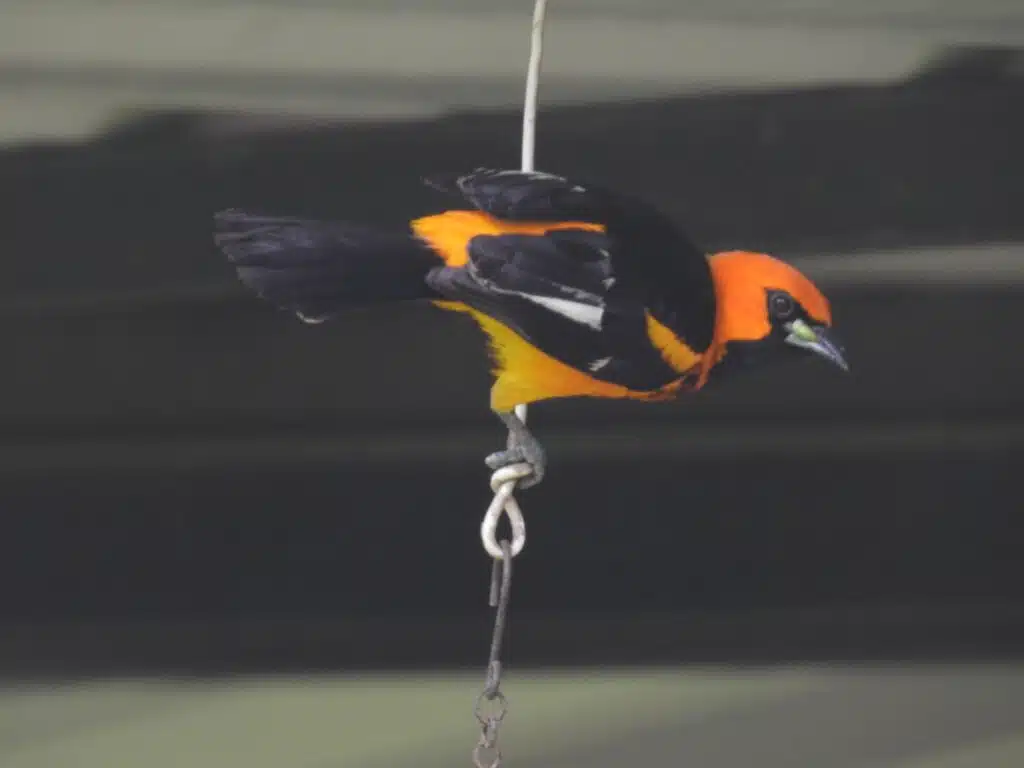
A bright orange head and bright orange underbellies are seen on male Spot-breasted Orioles (Icterus pectoralis).
This is a species with a black upper chest, a black face, and black wings.
Yellow and black color patterns dominate the appearance of females. While they have a darker yellow color, they still lack the orange head of the males as they have yellow crowns.
Reaching a size of around 4 inches, this species is found in tropical and subtropical forests.
It inhabits moist woodlands in the warm habitats of Central America.
While nobody knows for sure how many Spot-breasted Orioles are found in The United States, it’s only in Southern Florida that these birds have been confirmed.
Distribution – Mexico, Guatemala, Honduras, Costa Rica, Florida
Orange head – adult male
8. Northern Red Bishop
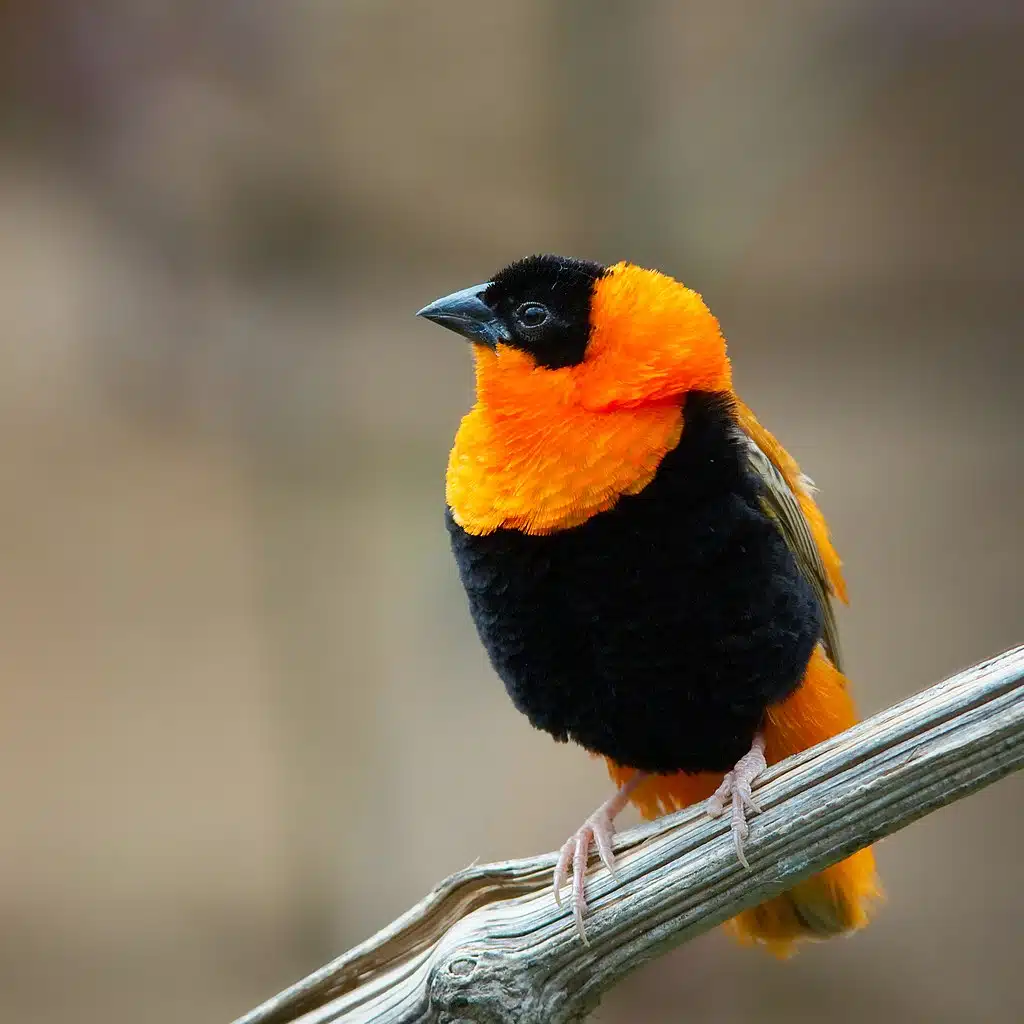
Northern Red Bishops (Euplectes franciscanus) are named after their vivid red and black coloring which is characteristic of the male bird through most of the year.
Once the breeding season arrives, its red color turns to orange. As a result, much of the time, the male has an orange head.
Orange and black contrasting colors are specific to the male in the breeding season while the females remain brown.
Northern Red Bishops are found in multiple countries around Northern Africa as well as in sub-Saharan Africa.
Their diet includes different types of insects as well as grasses such as cockspur grass.
Distribution – East Africa, sub-Saharan Africa
Orange head – adult male
9. Ruddy Shelduck
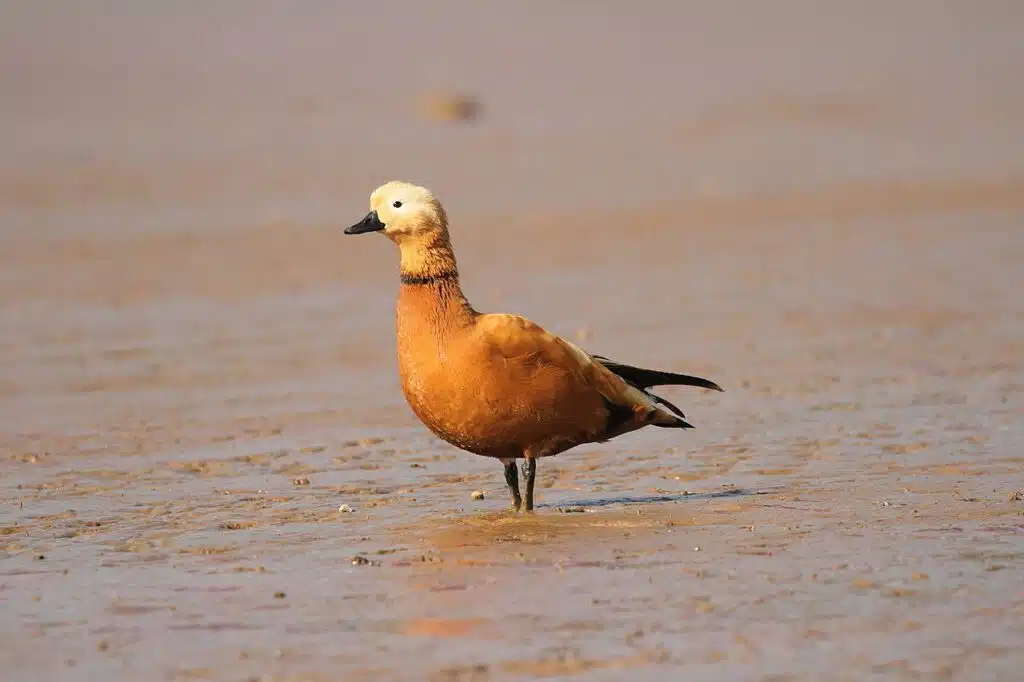
An orange head and orange plumage around the wings and body are specific to the male Ruddy Shelduck (Tadorna ferruginea).
This type of duck also has a black tail and females with a similar color but with a white head.
The females of the species have a similar bright orange color, a white head, and a similar black tail as seen on males of the species.
Some of the best times to spot this species start with April which marks the beginning of its breeding season.
A duck found on lakes, ponds, seas, and even in cities, The Ruddy Shelduck is a species that eats insects and vegetation, particularly young vegetation.
Distribution – India, Asia, Europe, Northern Africa
Orange head – adult male
10. Yellow Grosbeak
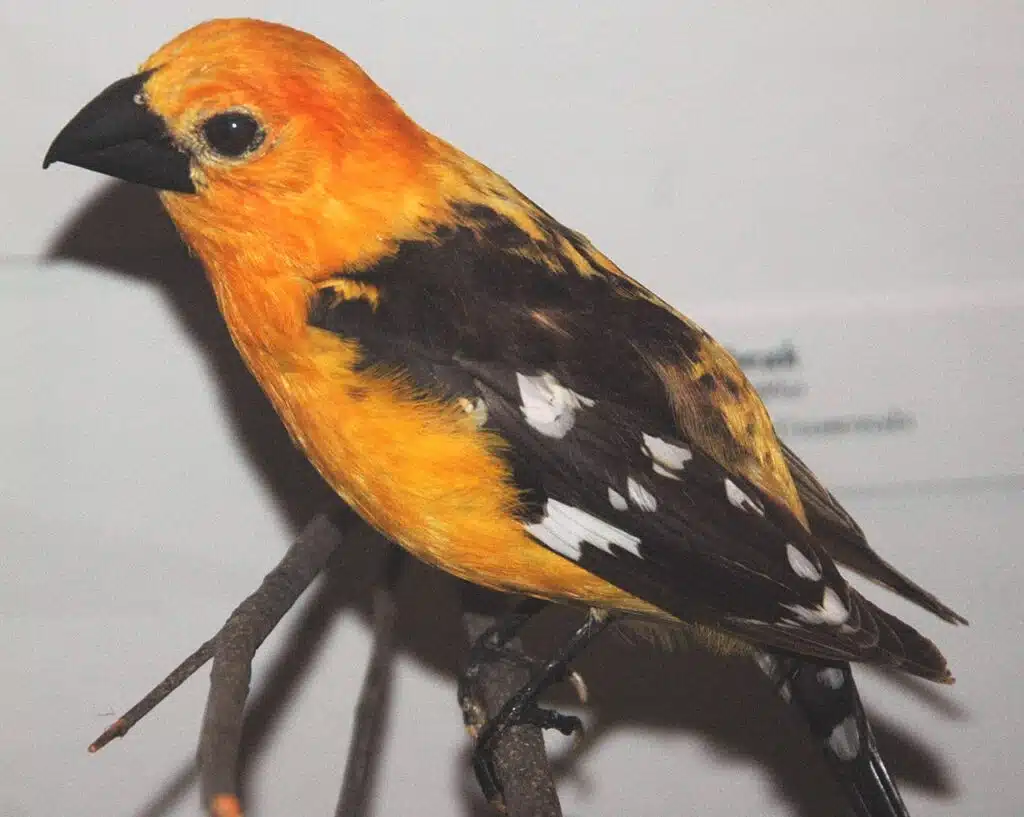
Yellow Grosbeaks (Pheucticus chrysopeplus) may have an orange head, depending on the season and their regions.
Males in Guatemala are more likely to have an orange head compared to the yellow head of males in other parts of the world.
The female of the species has a yellow head and underbelly with contrasting black wings.
Tied to Central American woodlands, this species migrates and is also found in The United States.
Migratory Yellow Grosebeaks are also found in the Northern and Central parts of South America.
Most birds of this species inhabit woodlands in the Western parts of Mexico.
Distribution – Mexico, Guatemala, California, Colorado
Orange head – adult male
11. Gang-gang Cockatoo
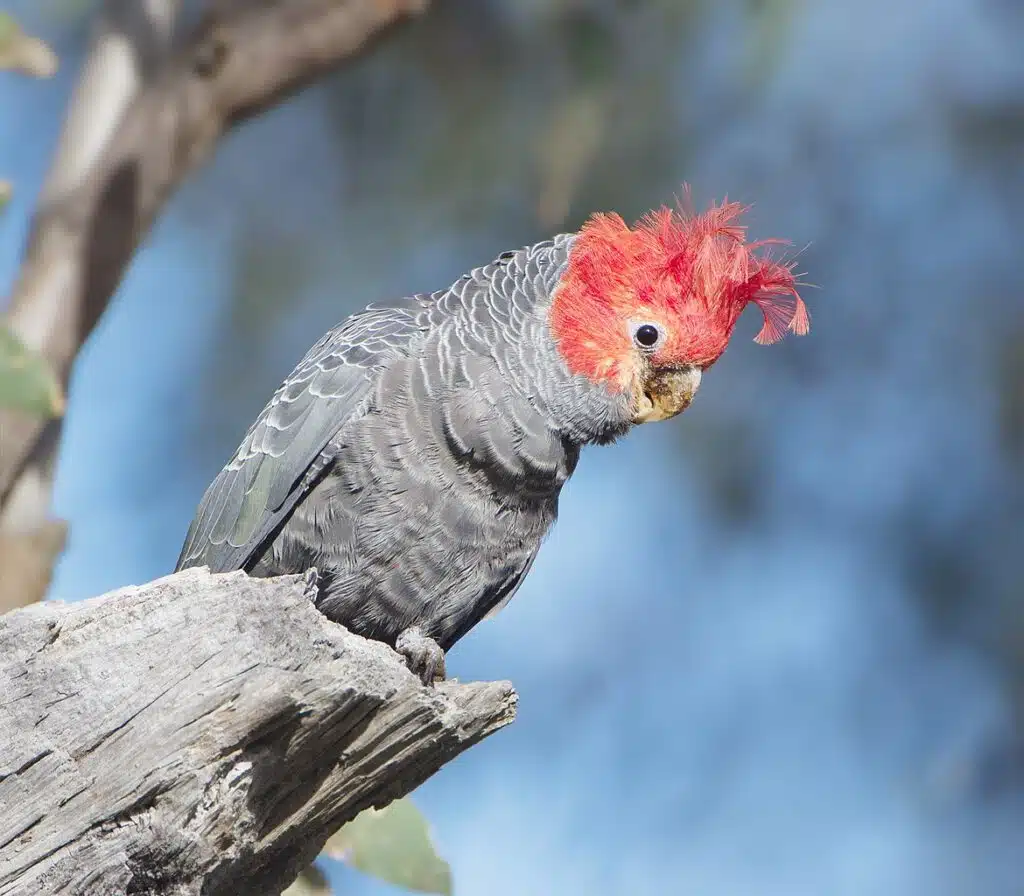
Small differences exist between male and female Gang-gang Cockatoo (Callocephalon fimbriatum) in terms of appearance.
The male shows a red-orange color and crest during the breeding season while the rest of its body is mostly gray.
Females have a gray head and a similar gray color across the body and the wings.
Woodlands and trees are the main areas where these birds live. They build cavities and they breed and live on trees.
Found in Southeast Australia, this species is believed not to be as numerous as it used to be. Gang-gang Cockatoos are now protected by law.
Distribution – Southeast Australia, Tasmania
Orange head – adult male
12. Southern Red Bishop
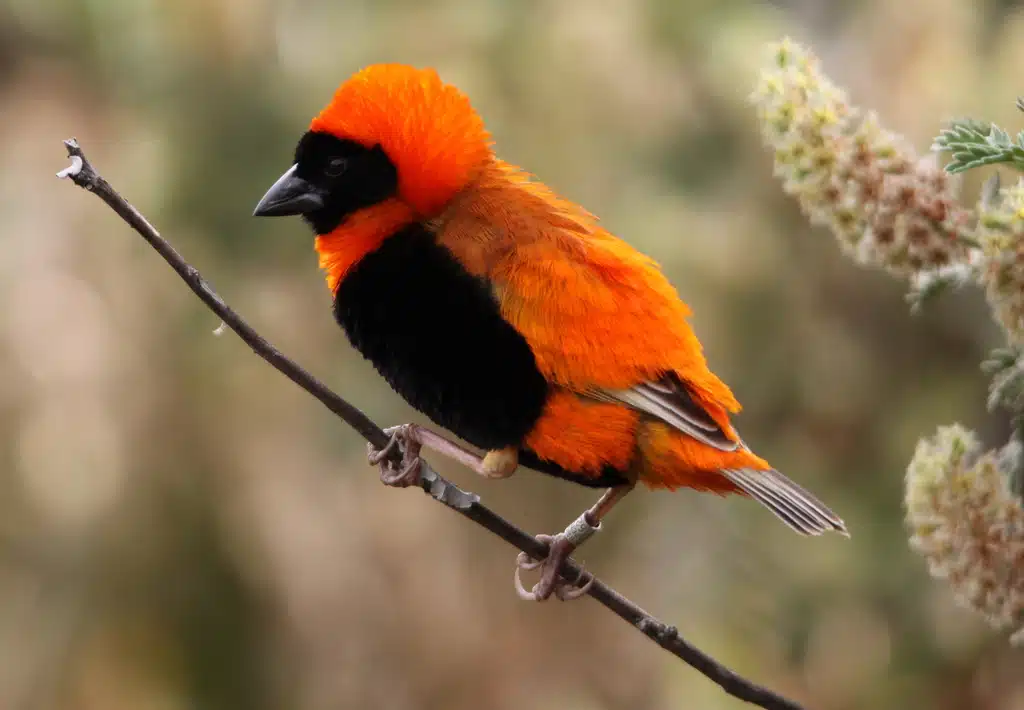
Southern Red Bishop (Euplectes orix) heads have either orange or red coloring. This variation indicates its maturity and even its season as these birds are only orange in the breeding season.
Females have brown and gray heads with similar color contrasts across the body.
Both males and females may be spotted in pairs during the breeding season and on their own or in small groups outside of the breeding season.
An African native, this species goes through considerable color changes as it enters the breeding season.
While males have an orange head, they also show a black face with an additional orange hue at the tip of their wings.
Apart from changing its colors to attract females, male Southern Red Bishops also build nests to attract females.
Distribution – Africa
Orange head – adult male
13. Orange-headed Tanager
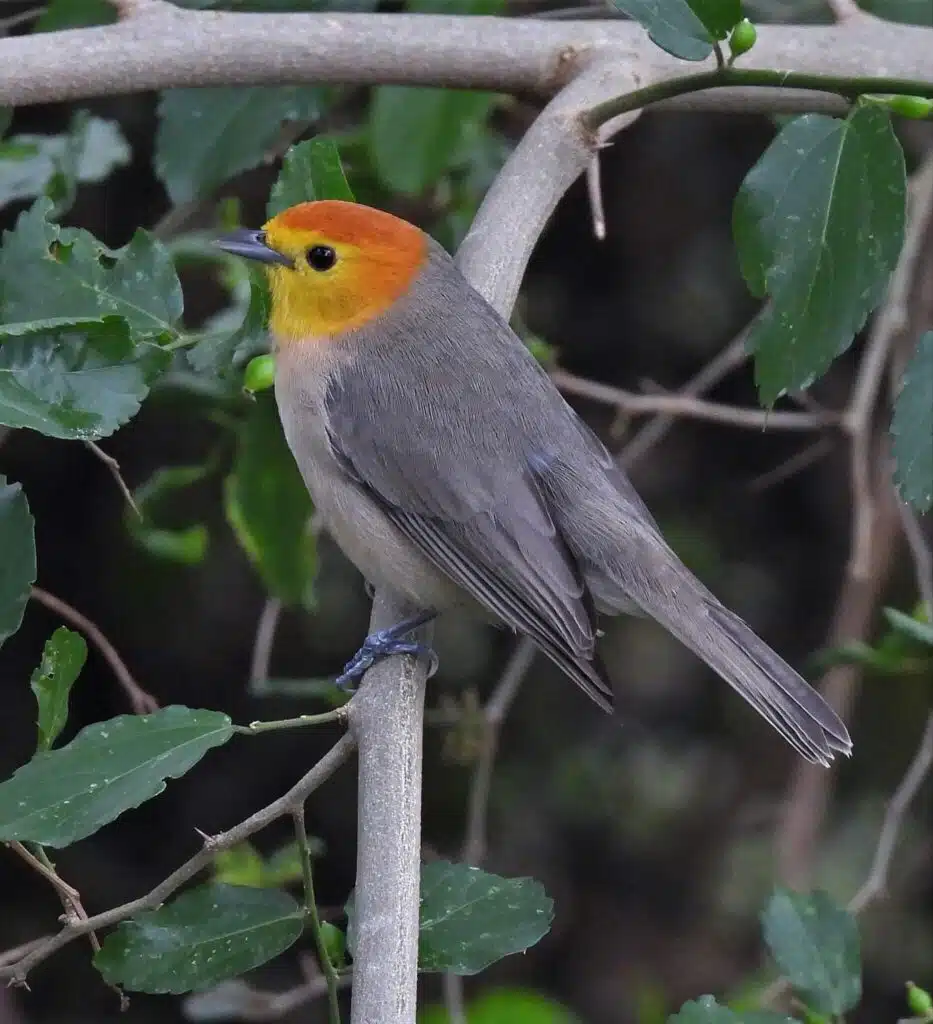
The beginning of the breeding season marks the period when The Orange-headed Tanager’s (Thlypopsis sordida) head turns orange, from yellow.
Females have a yellow head and the general plumage of the species also varies depending on their region.
Found in open areas of woodlands and along the woodlands of South America, this is a species that has a different appearance on the Western side of the continent.
It has a gray and white body across the Western parts of South America and a light brown nuance with a white belly in the Eastern parts of the continent.
Much of its presence on the continent is tied to the moist woodlands of Brazil.
Distribution – Brazil, Ecuador, Peru, Chile, Paraguay, Uruguay, Bolivia
Orange head – adult male
14. Orange-backed Troupial
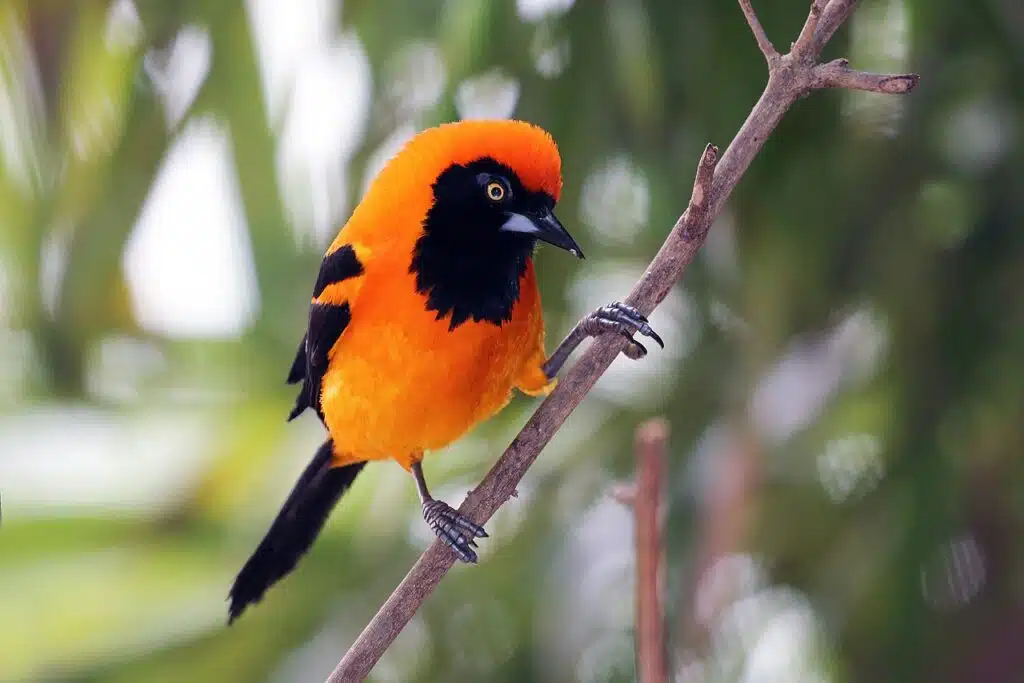
Mostly found around The Amazon Basin, The Orange-backed Troupial (Icterus croconotus) is a species with a bright orange head.
Even more, this is a species that also has a bright orange back and belly. Its wings show a black base color with white marks while its eyes are orange and black as well.
Birds of this species show long black tails and elongated gray beaks.
Growing to a size of up to 9 inches, Orange-backed Troupials live around moist woodlands and in areas with plenty of trees along streams and rivers.
The species is native to South America where it’s estimated its numbers are declining at a slow pace.
Distribution – Brazil, Guyana, Ecuador, Bolivia
Orange head – adult males and females
15. Band-tailed Manakin
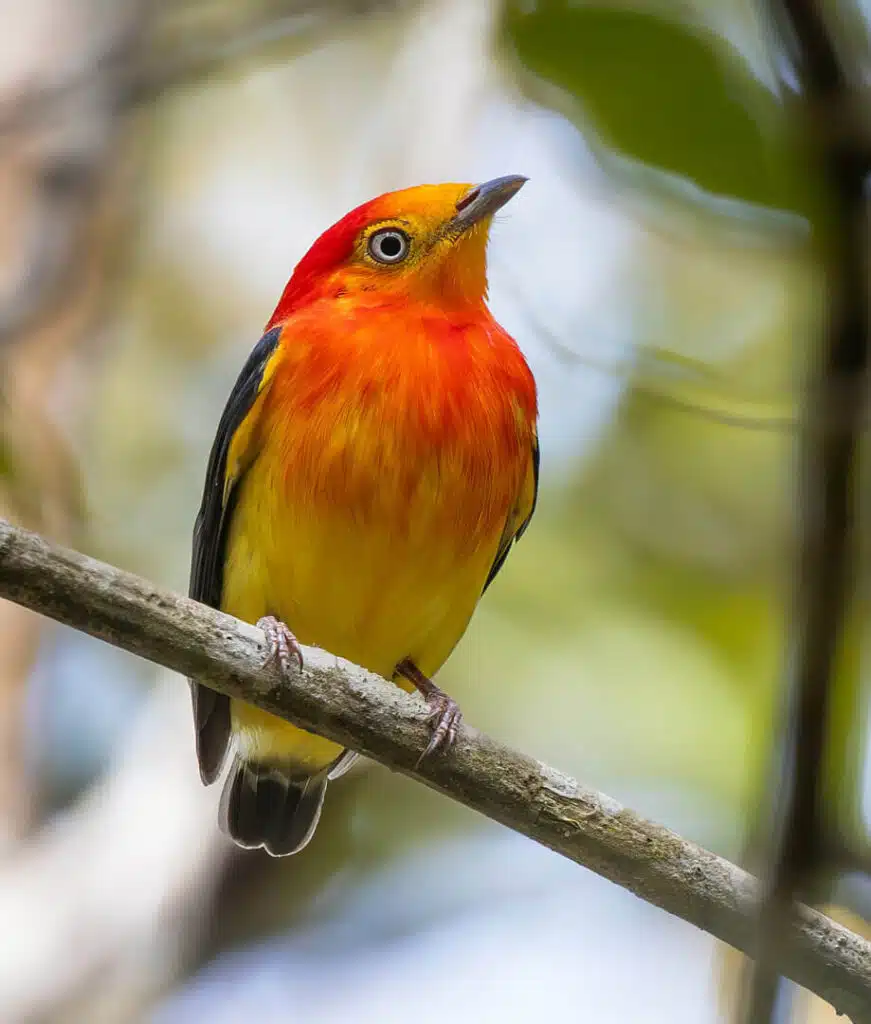
The Amazon Basin with its deep rainforest is also home to The Banded-tailed Manakin (Pipra fasciicauda).
As a small species that reaches a size of 8 inches, this bird shows coloring differences between males and females.
An orange or red-orange head is characteristic of the breeding season male.
Its neck and chest are also orange while the lower belly is yellow. The wings, beak, and eyes of the male are black.
Females of the species have a yellow-olive color head and body and don’t change colors going into the breeding season.
Juveniles of the species have yellow and orange face coloring but have a yellow-dominating appearance.
Distribution – Brazil, Peru, Bolivia, Paraguay
Orange head – adult male
16. Guianan Cock-of-the-Rock
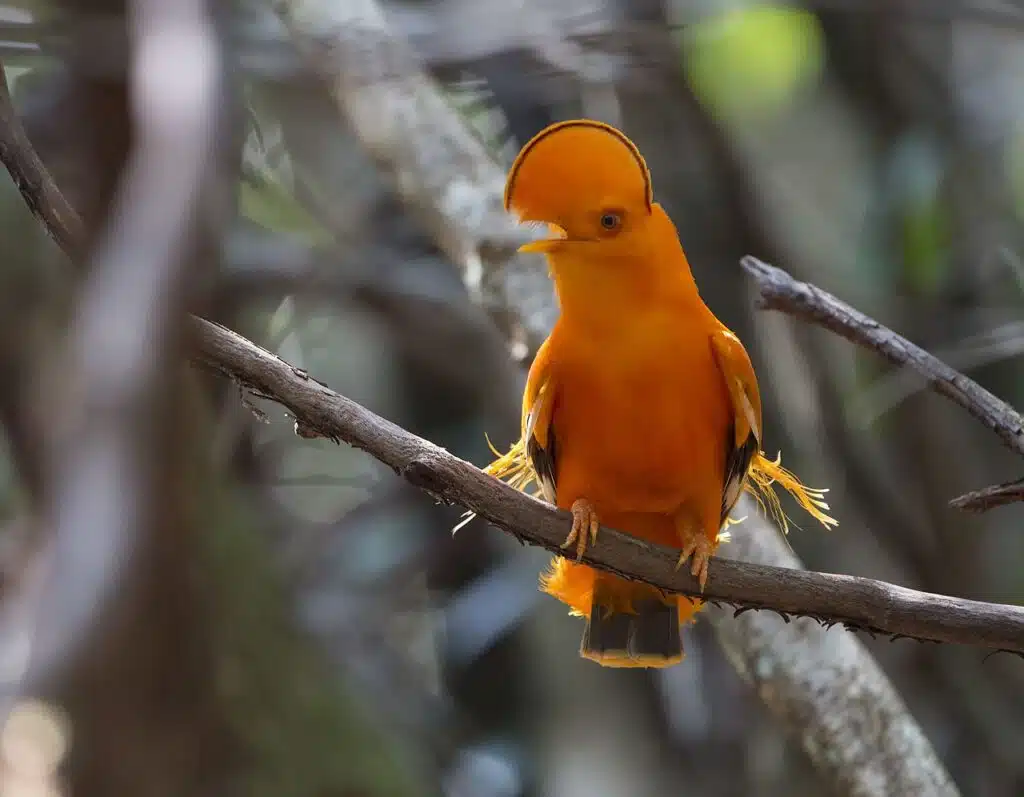
Vivid orange heads and overall coloring is specific to the plumage of the male Guianan Cock-of-the-Rock bird (Rupicola rupicola).
This is a species found in the Northern parts of South America with a contrasting look and distinct breeding habits.
Males are mostly orange with an orange head and an orange crest.
Females have a dark gray to black appearance and may show orange coloring along the sides of the head only in their juvenile days.
Males of this species are known to be territorial. They clear out vegetation on the ground in a given area as a means to impress the female and attract a potential breeding partner.
Distribution – Northern South America
Orange head – adult males, juvenile females
17. Chestnut-headed Tanager
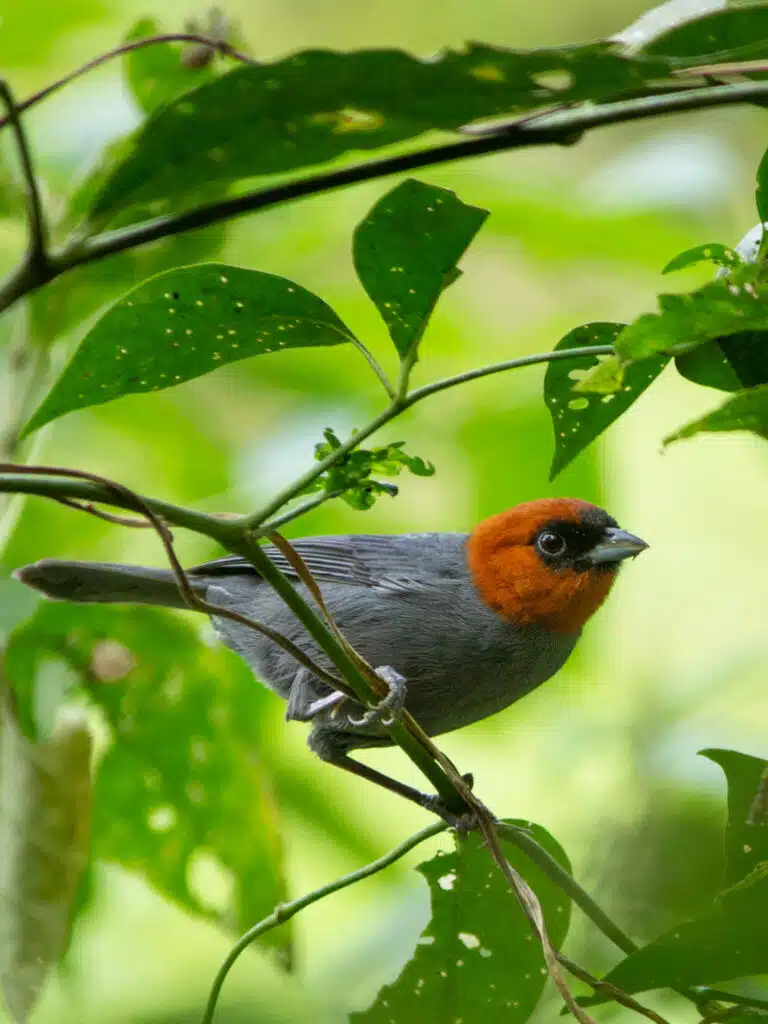
Adult males show contrasting orange heads. Their body and wings are gray, as are its beak and legs.
Male Chestnut-headed Tanager (Thlypopsis pyrrhocoma) can also have a chestnut-brown head, particularly when not breeding.
A black mask is also specific to the head of the male regardless of its breeding status.
Females of the species have a chestnut-brown head and a brown-gray body. They also have long gray wings.
Only found in South American woodlands, this bird species is known for its squeaking-like high-pitched vocalizations.
This species is found in coastal areas and woodlands close to coastal areas in the Eastern parts of South America.
Distribution – Southern Brazil, Paraguay
Orange head – adult male
18. Broad-billed Motmot
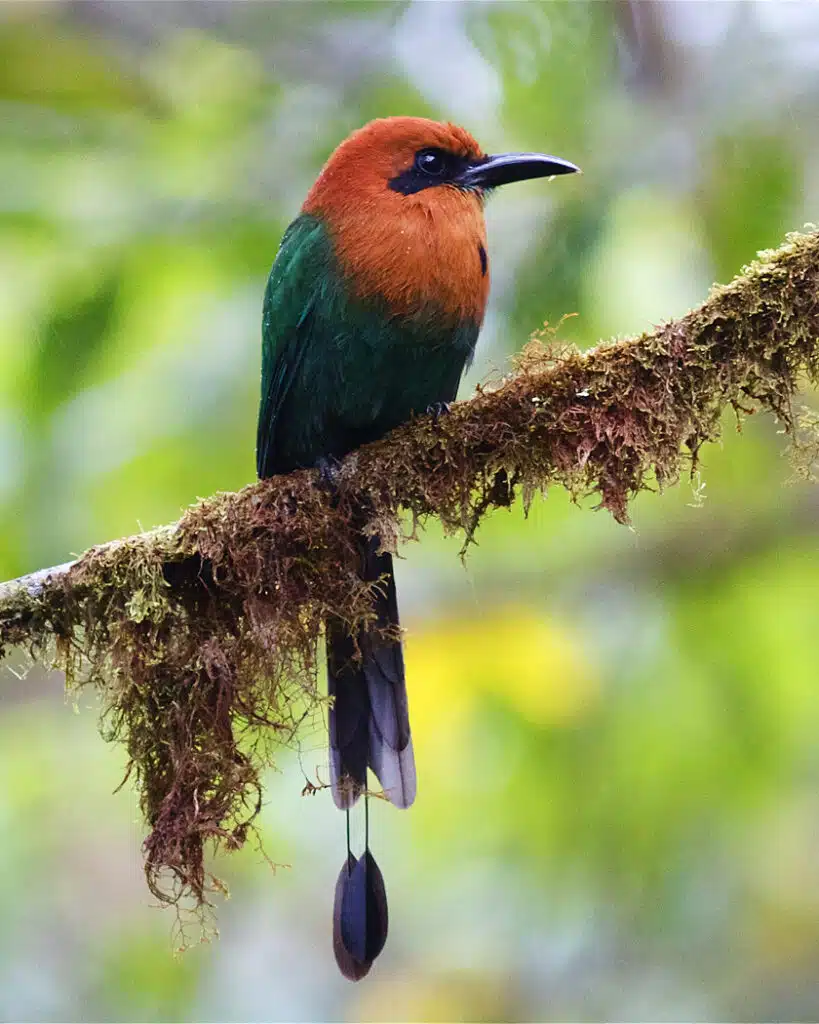
Broad-billed Motmots (Electron platyrhynchum) are among the few species where both males and females share the same orange head color.
The head and shoulders of these birds are orange or dark orange with the rest of the body having a dark green appearance.
A metallic green hue is specific to the wings and underbelly of these birds.
As the name of the species implies, Broad-billed Motmots also have long bills which are always black.
The tail of the species is either blue or black, depending on the breeding season of these birds.
An insectivorous species, Broad-billed Motmots have a repertoire of multiple songs or vocalizations.
Distribution – Brazil, Panama, Honduras, Ecuador, Colombia
Orange head – adult males and females
19. Rainbow Bee-Eater
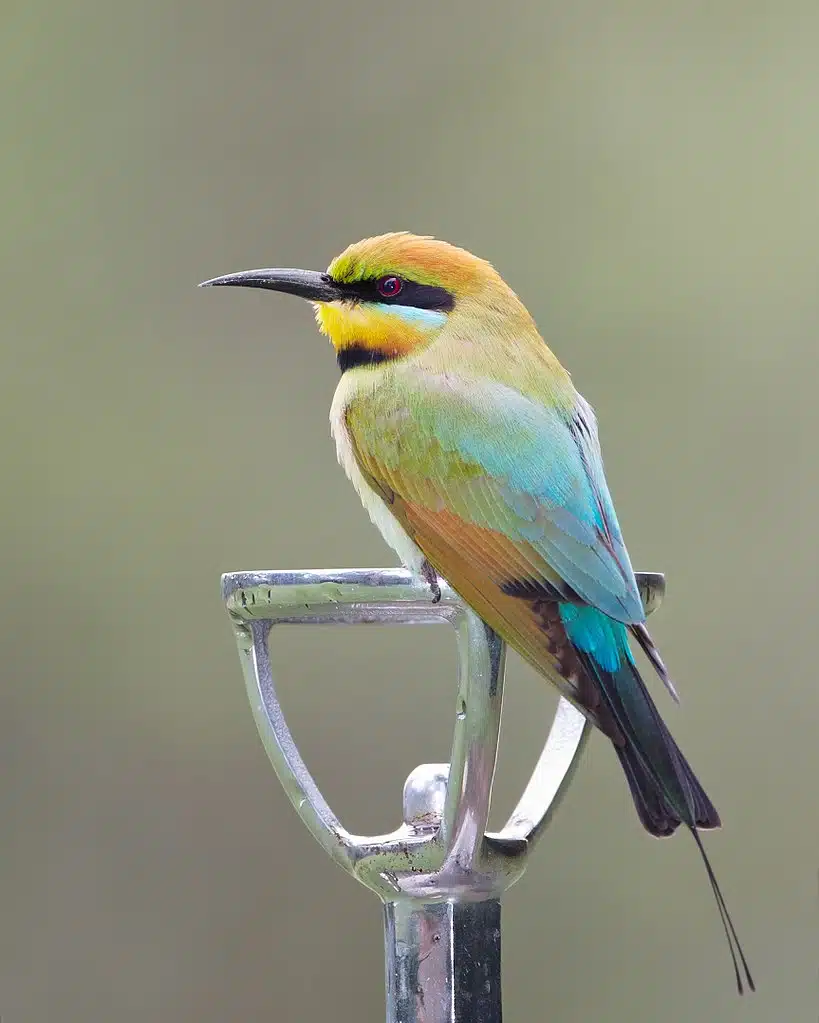
An orange crest is specific to The Rainbow Bee-Eater (Merops ornatus). Named after its multicolored appearance, this type of bird has a yellow face with a black mask and yellow, blue, and green wings.
As its name implies, this bird is specialized in eating bees, with a negative role in the ecosystem.
Rainbow Bee-Eaters are specialized in eating different types of bees and are even immune to bee stings.
These birds have very specific tactics they rely on to catch bees. They catch them in flight and they capture them in the beak.
Bees are rubbed against a hard surface to break off their stinger just before being swallowed by the birds.
Some positive attributes to the ecosystem are also tied to these birds as they are also known to eat invasive bugs such as wasps.
Distribution – Australia, Tasmania
Orange head – male adult
20. Yellow-billed Kingfisher
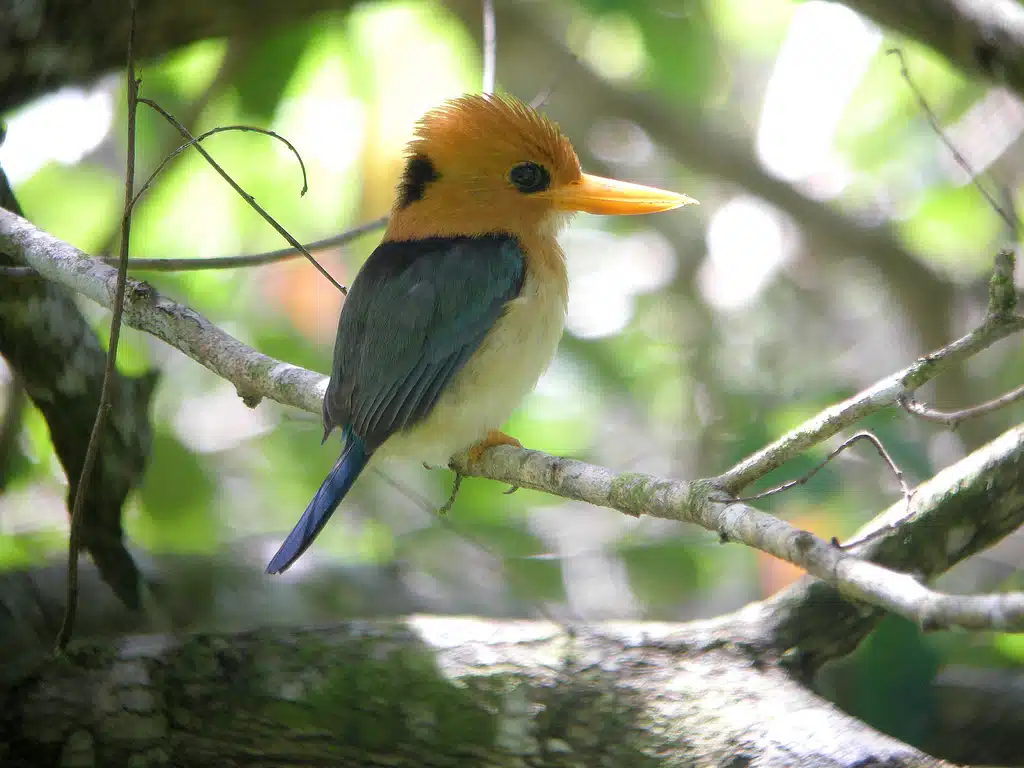
An orange head is specific to both Yellow-billed Kingfisher (Syma torotoro) males and females.
The amount of orange coloring differs between the sexes, on the other head. Males’ head is mostly orange while females have black crown.
Large black eyes are characteristic of both males and females.
There’s a large black spot behind the head of these birds as well.
Much of the chest of the male is mostly orange, as is the belly. The underbelly of the female is mostly white to yellow.
An elongated yellow beak is seen both in males and females.
The wings of the species are dark, typically represented by green and brown color combinations.
A green tail is also specific to male Yellow-billed Kingfishers.
Distribution – Australian and New Guinean rainforest
Orange head – adult males and females
21. Black-tailed Godwit
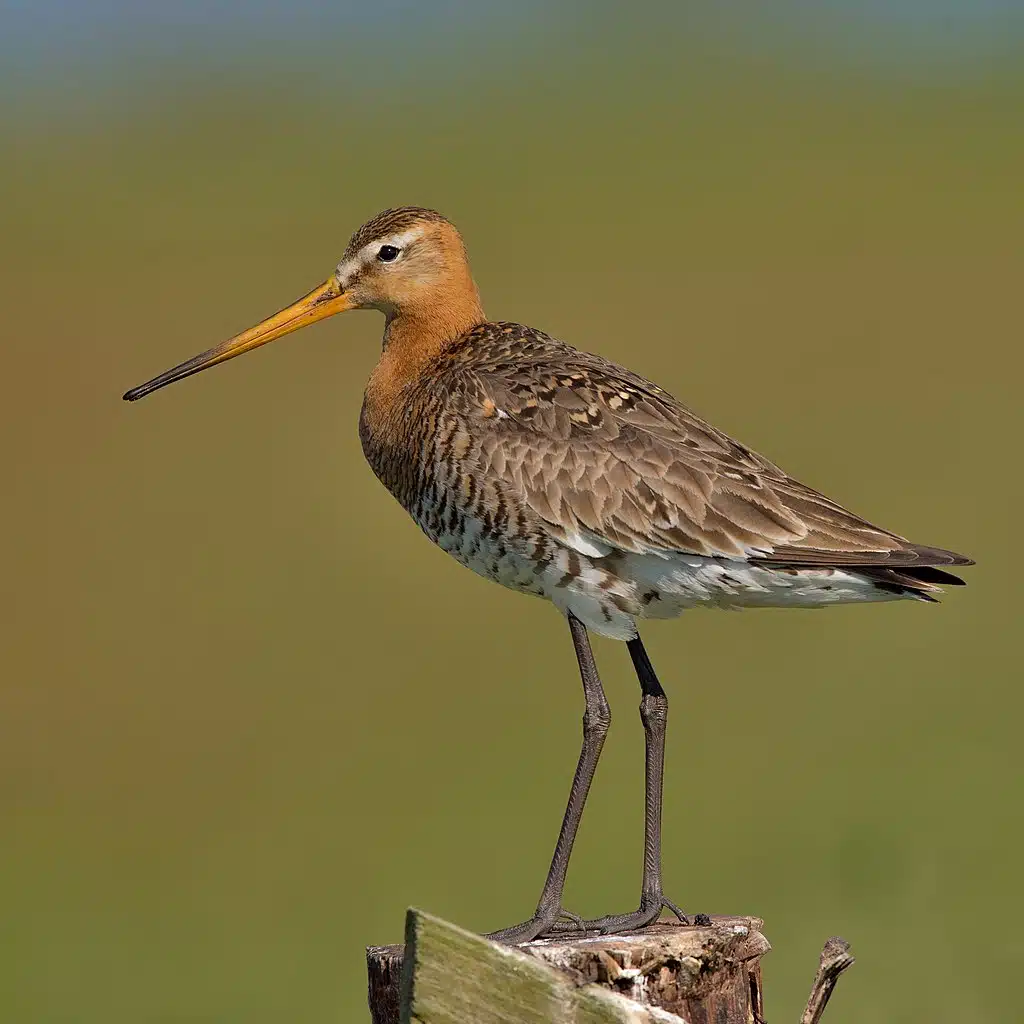
An orange head and chest are highly characteristic of all of the subspecies of The Black-tailed Godwit (Limosa limosa).
A widespread species with a very long beak, this bird is also known for having a yellow to orange beak during the breeding season.
Juveniles of the species are also marked by orange colors, but they only have an orange chest before turning into adults.
Gray, white, and brown plumage is specific to the back, belly, and wings of the species.
Found across Europe and Asia, Black-tailed Godwits are known for their long migration to Africa to overwinter.
It’s estimated there are almost 1 million birds of the species around the world as they have few natural predators.
Distribution – Europe, Asia, Africa
Orange head – adult male
22. Japanese Robin
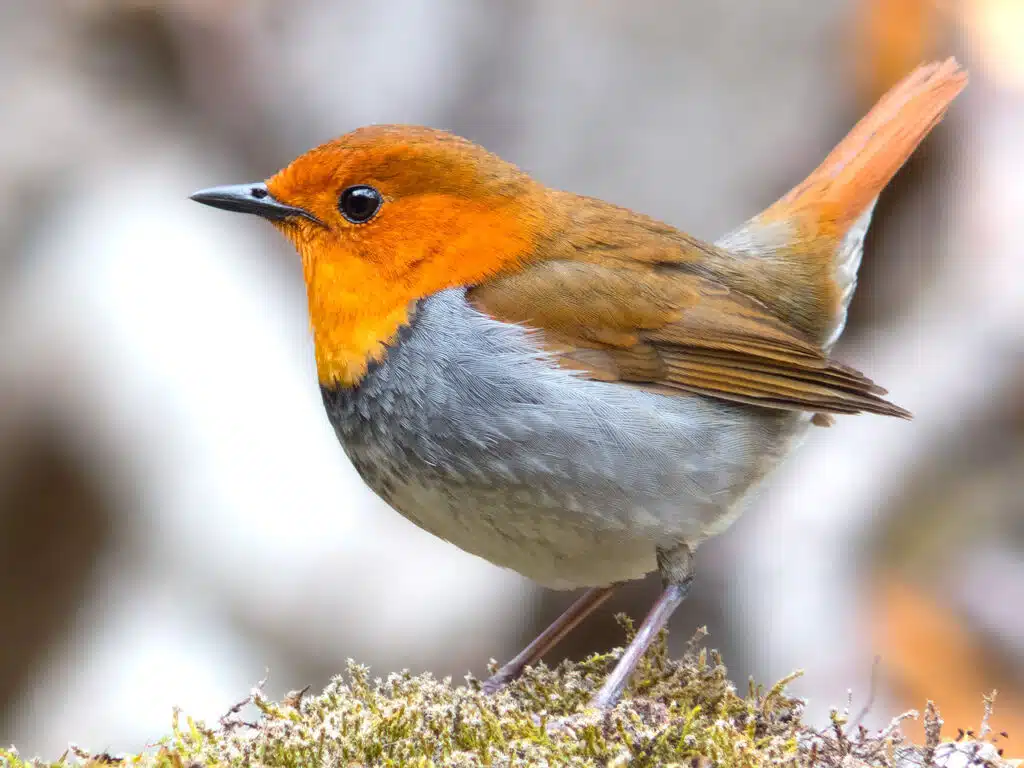
Japanese Robins (Larvivora akahige) are widespread birds with orange heads. A bright orange color is representative of the head of the male Japanese Robin.
Brown and gray color combinations are specific to the rest of its body.
Females lack the orange head color as they are yellow and brown, with a gray belly and brown wings.
Woodlands and remote islands are among the ideal habitats for this species. The presence of moist woodlands attracts the small insects these birds eat.
Some of the most common places where this bird can be found include the forest floor where it seeks out insects among fallen leaves.
Distribution – Japan, South Korea, East China
Orange head – adult male
23. Orange-headed Thrush
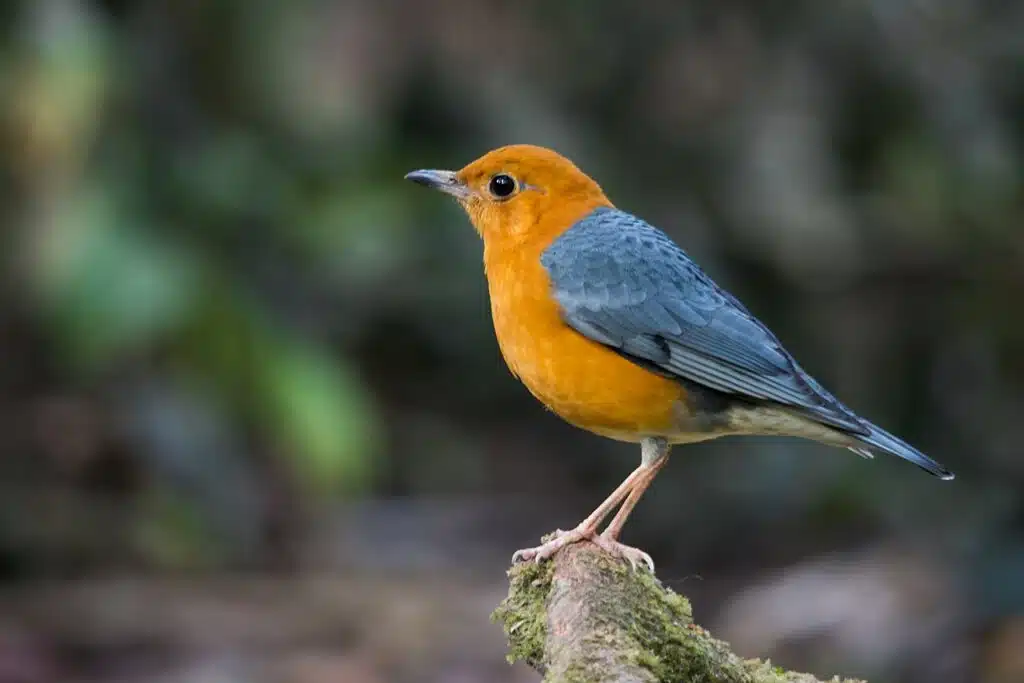
As its name implies, this species (Geokichla citrina) has an orange head, but only in the case of males as females have a brown head.
The Orange-headed Thrush is a species with a bright orange head and yellow coloring around the eyes.
Males have graphite-gray wings similar to those of females.
The orange head of the male bird darkens and takes on a red-orange nuance during the breeding season.
All types of evergreen woodlands are an ideal habitat for Orange-headed Thrushes.
These birds live in moist woodlands including bamboo woodlands in Asia.
Distribution – Pakistan, India, Bangladesh, Vietnam, Cambodia
Orange head – adult male
24. Flame-colored Tanager
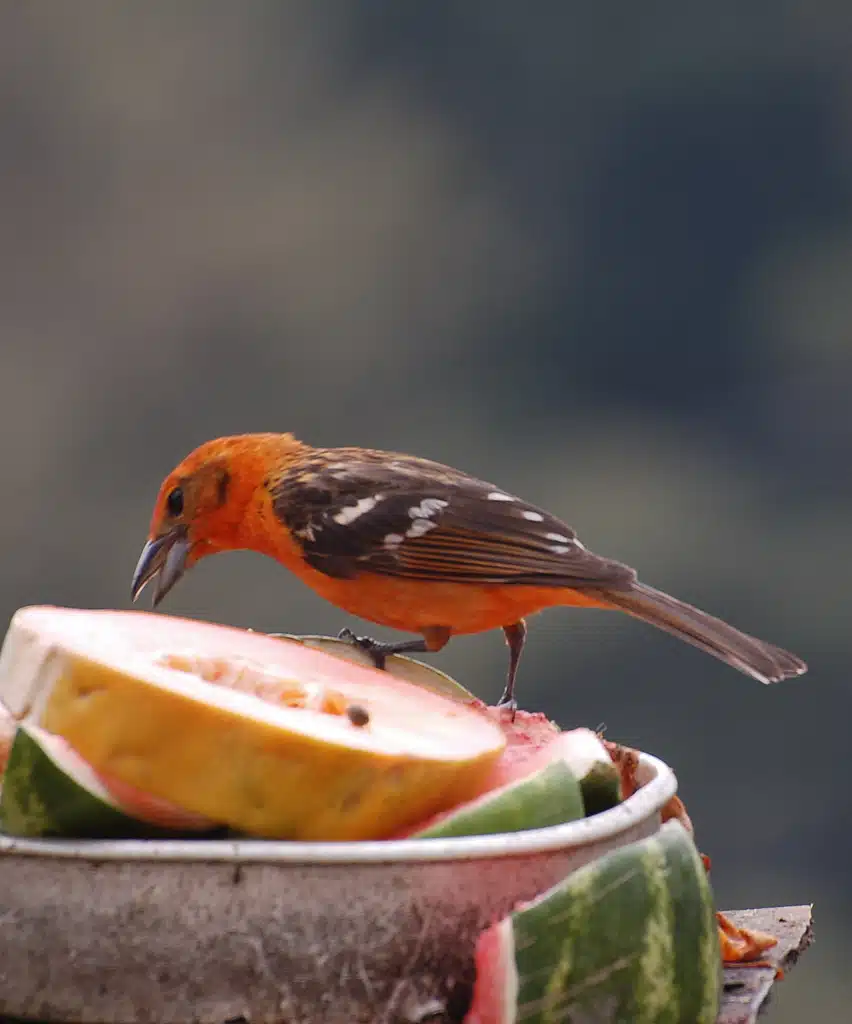
The 4 subspecies of Flame-colored Tanagers (Piranga bidentata) are known for their vivid orange heads. Males of the species show an orange-red head and similar underbelly coloring.
They feature contrasting black beaks and eyes. Males of the species also have black wings.
Female Flame-colored Tanagers have a yellow-dominating color with slight orange undertones.
Native to Central America, Flame-colored Tanagers eat all types of spiders and caterpillars. They are further identified by their numerous vocalizations.
Distribution – Mexico, Costa Rica, Nicaragua, Southern Arizona, Southern Texas
Orange head – adult male
25. Streak-Backed Oriole
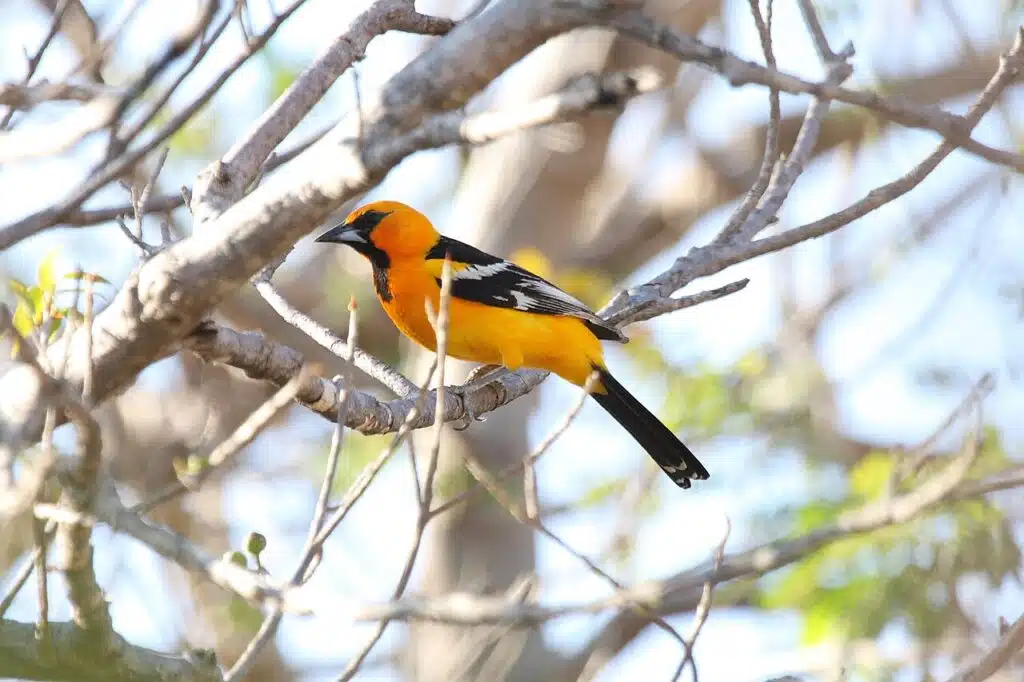
Rare visitors in The United States, Streak-Backed Orioles (Icterus pustulatus) are among the species that may reach Texas and Arizona in the Southern parts of the states.
Native to Central America, Streak-Backed Orioles have an orange head and bright orange coloring across the back and belly in the case of males.
These birds have orange wings at the base while the rest of the wings are black and white.
Birds of the species have long black tails.
Black face masks are specific to males and females of the species.
The female has a yellow-brown color and bright gray wings. They have a yellow-olive tail and not a black tail like males.
Distribution – Mexico, Guatemala, Costa Rica, Panama, Southern California, Southern Arizona, Southern Texas
Orange head – adult males
26. Scarlet-Headed Blackbird
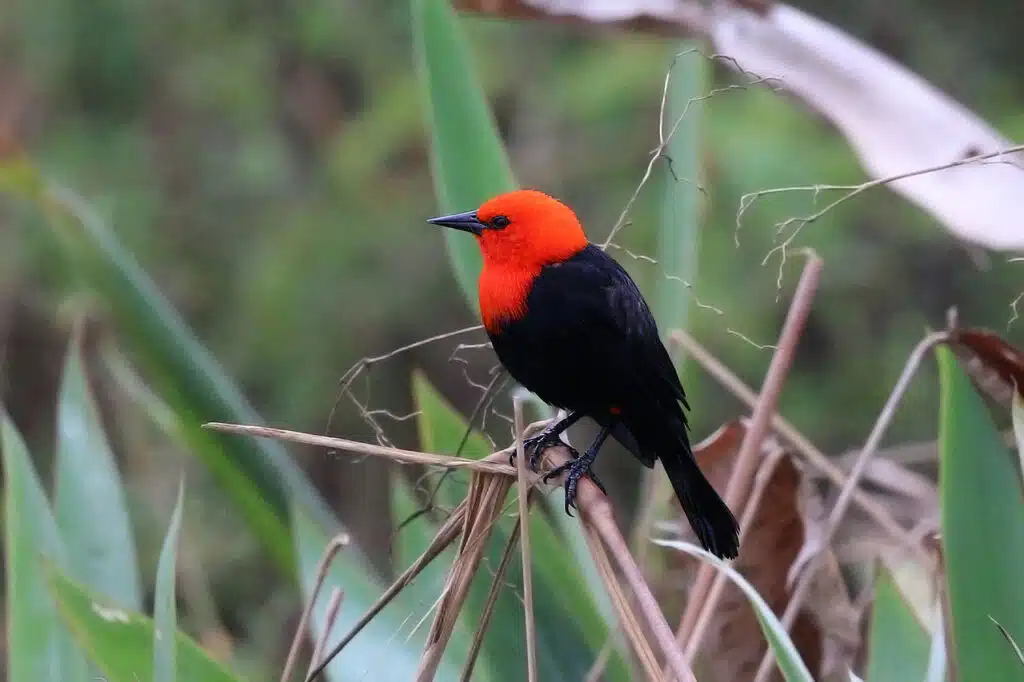
The vivid orange coloring is specific to the heads of The Scarlet-Headed Blackbirds (Amblyramphus holosericeus).
The species has a blood-orange color which is darker in the breeding season and closer to yellow outside of the breeding season.
A contrasting black body is specific to these birds which also have an orange chest but a black underbelly.
Their wings are also black, as are their split tails.
A black beak is also specific to Scarlet-Headed Blackbirds.
Spotting these birds is easy since they live in large flocks. Most of these flocks are found around marshes.
The bulk of their diets is represented by fruits, even if they can eat almost anything they can find, including live insects.
Distribution – Bolivia, Paraguay, Uruguay, Argentina
Orange head – adult males and females
27. Andean Cock-of-the-Rock
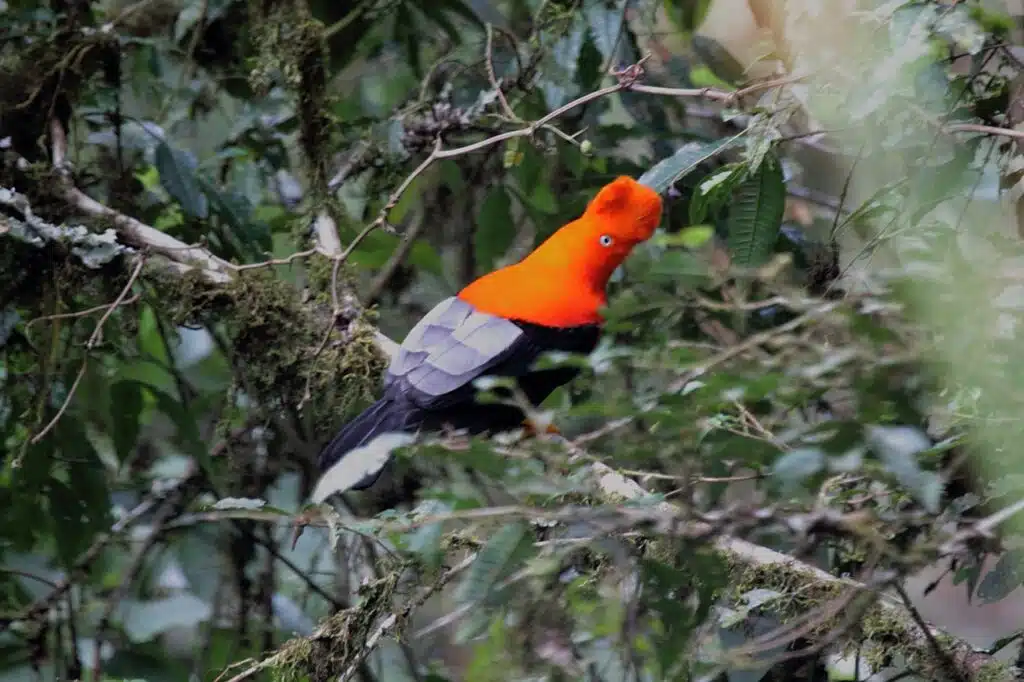
One of the species with clear orange head coloring and orange bills includes The Andean Cock-of-the-Rock (Rupicola peruvianus).
The orange appearance of males is amplified by a small orange crest.
Apart from orange heads, the males of this species have orange shoulders and upper chests, while the rest of their bodies are black.
Females lack the clear dual color contrasting appearance of males as they’re mostly light brown.
Found along South America’s Andean Mountain range, these birds can feed on small insects and even small reptiles.
They are also prey to larger predators such as hawks due to their easily noticeable orange appearance.
Distribution – Peru, Bolivia, Ecuador, Colombia
Orange head – adult males
28. Lesser Striped Swallow
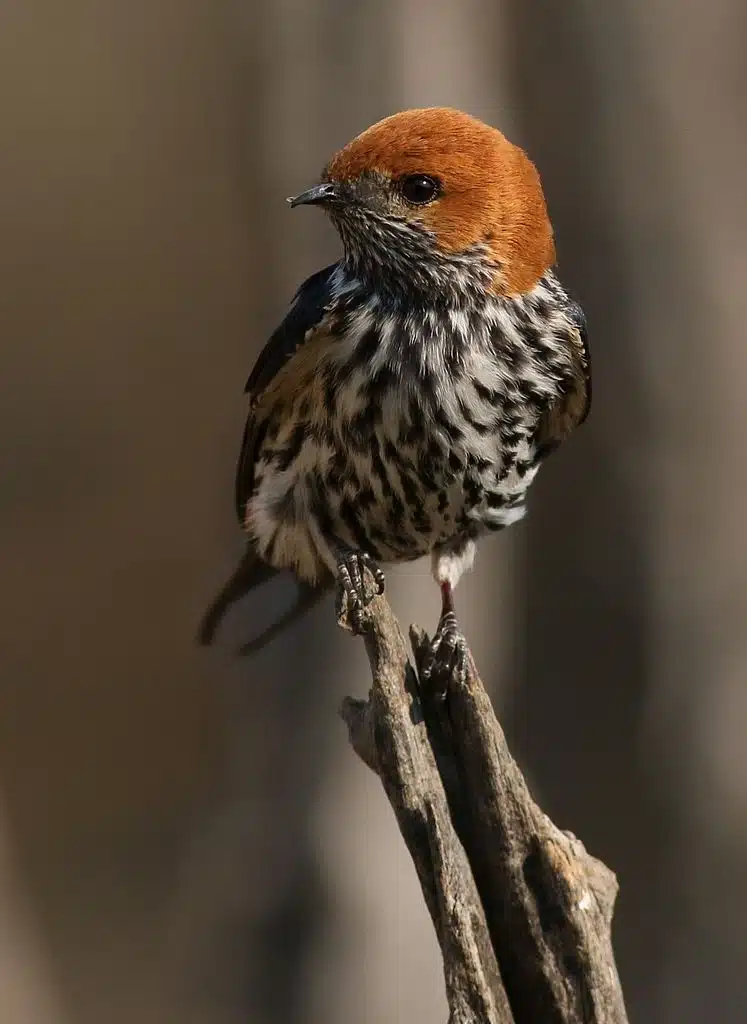
An orange head is specific to this African bird species (Cecropis abyssinica). The male Lesser Striped Swallow has a vivid orange head and a black and blue body color combination.
Their bellies show a white and orange color combination while their tails are black.
Females of the species have a dark chestnut head color and a brown body with black wings and a long black split tail.
Most types of Lesser Striped Swallows live in open areas next to woodlands.
They often migrate to the lower parts of the continent in the dry months.
Distribution – West Africa, Central Africa, Southeast Africa, Southern Africa
Orange head – adult male
29. Eurasian Wigeon
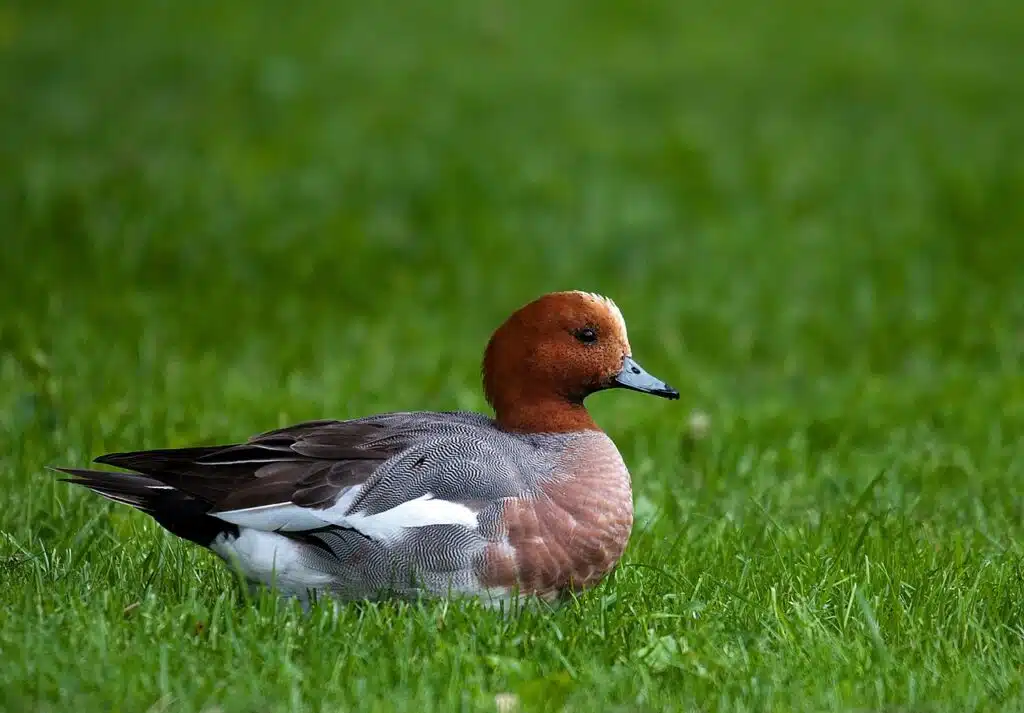
The Eurasian Wigen (Mareca penelope) male duck may take on orange-colored head plumage in the breeding season.
This duck has a brown head outside of the breeding season and gray wings with a black tail.
Females are dull-colored and dominated by different nuances of gray with contrasting dark brown wings.
Found along wetlands of Europe and Asia, this species feeds on aquatic vegetation, often plucking its head in water for the youngest aquatic plants.
The beginning of the breeding season marks the period when the male changes its head color and when it starts to whistle as a typical vocalization that attracts females.
Distribution – Asia, Europe, Africa, North America
Orange head – adult male
30. House Finch
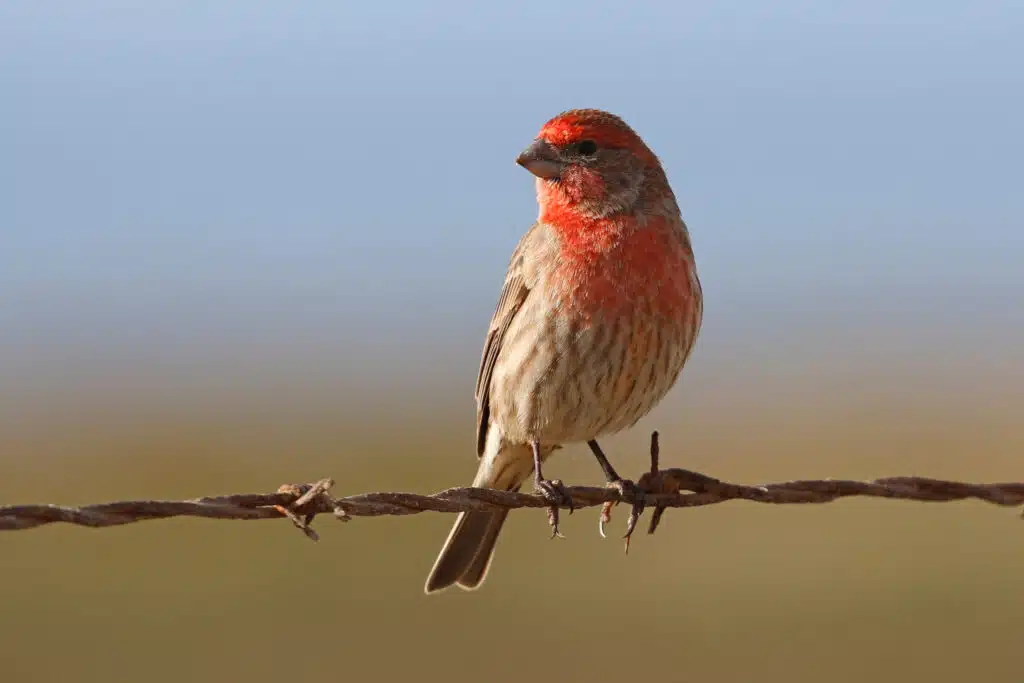
One of the most numerous species of North America, The House Finch (Haemorhous mexicanus) often comes in an orange head.
The color of the male’s head varies, however. It may not always be orange as it can also be yellow, as opposed to the brown streaked head of the female.
The male House Finch also has orange streaks along its chest.
First only present in Mexico, House Finches have spread quickly through North America.
Even the most conservative estimates believe there are at least a few hundred million House Finches across North America.
Some male House Finches even appear in the red head but all of its morphs depend on plants and seeds as food.
Birds of this species are particularly known to eat flowers apart from seeds.
Distribution – The United States, Canada, Mexico
Orange head – some adult males
31. Yellow-headed Blackbird
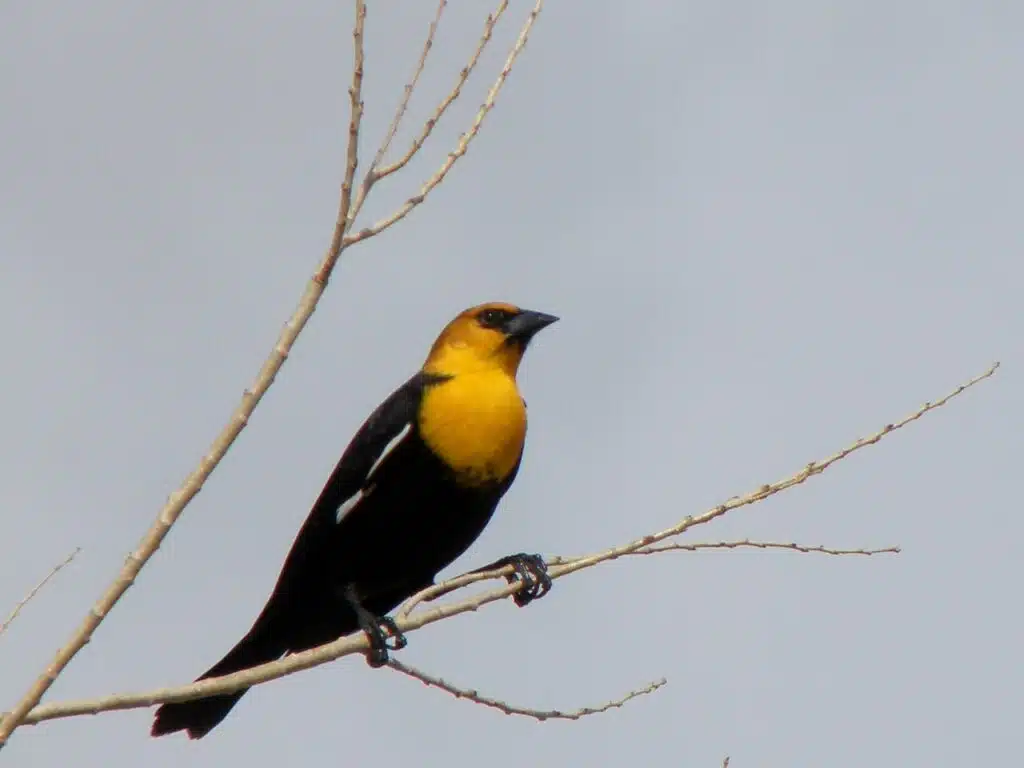
Orange head and chest coloring are specific to the mostly black Yellow-headed Blackbird (Xanthocephalus xanthocephalus).
This is an adaptation following a yellow head color going into the breeding season.
Females of the species are mostly dark brown and yellow-orange on the chest.
Found along the Western and Eastern sides of The Rocky Mountains, these birds are typically seen when migrating in large flocks.
Yellow-headed Blackbirds have a rusty call head during the breeding season and the migration to Mexico.
Birds of this species may continue living and foraging in large flocks to lessen the impact potential predators may have on them.
They feed on insects and often dig around pebbled and vegetation to uncover small bugs.
Distribution – Western United States, Western Canada, Mexico
Orange head – adult males
32. Vermilion Flycatcher
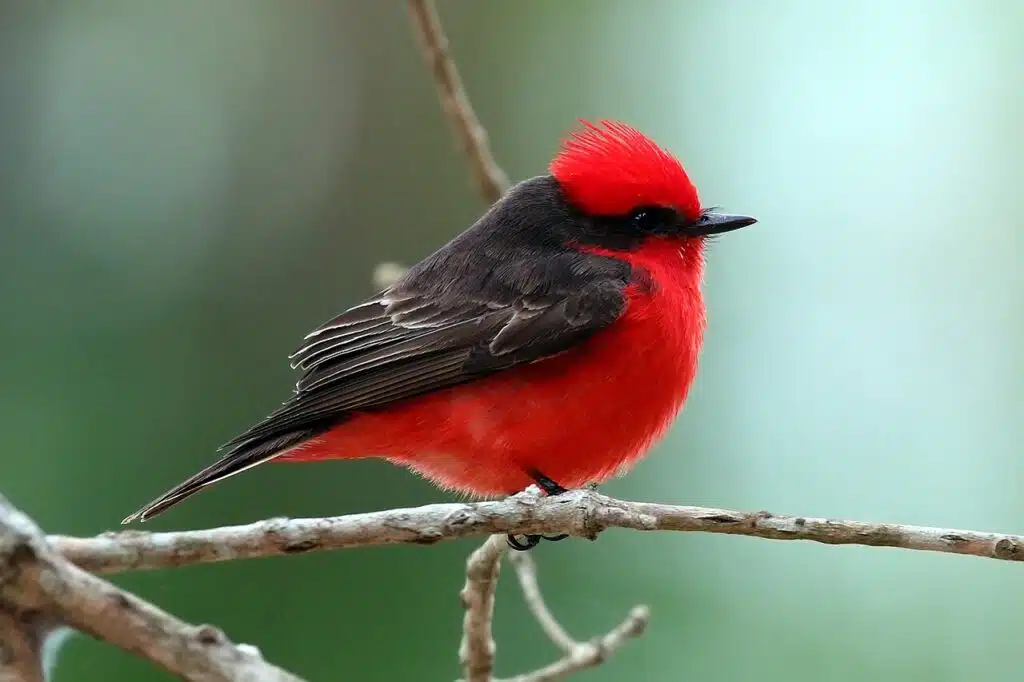
A small bird with pointy wings, The Vermilion Flycatcher (Pyrocephalus rubinus) can show a bright orange head or a bright red head in the case of breeding males.
Darker orange nuances are seen on the head and crown of the male with brighter orange coloring specific to its underbelly while its pointy wings are mostly gray.
Females have white and yellow bellies with gray heads and gray wings.
Open woodlands are among the ideal habitats of The Vermilion Flycatcher, a species already established in the southernmost limits of The United States.
Distribution – California, Nevada, Arizona, Texas, Louisiana, Georgia, Florida, Mexico, Colombia, Brazil, Paraguay, Uruguay, Argentina
Orange head – adult males